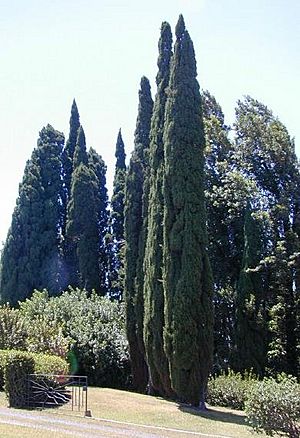Mediterranean cypress facts for kids
Quick facts for kids Mediterranean cypress |
|
|---|---|
 |
|
| Conservation status | |
| Scientific classification | |
| Genus: |
Cupressus
|
| Species: |
sempervirens
|
 |
|
| Green: probable natural range in the Mediterranean Basin Orange: range including human introductions Red (small areas): Residual natural stands |
|
The Cupressus sempervirens, also known as the Mediterranean cypress, is a tall and slender tree. People also call it the Italian cypress, Tuscan cypress, Persian cypress, or pencil pine. This special tree is originally from the eastern Mediterranean region. It is a type of cypress tree.
Contents
What is the Mediterranean Cypress?
The Mediterranean cypress is famous for its unique shape. It grows very tall and narrow, almost like a pencil or a column. This makes it easy to spot in landscapes. These trees can live for a very long time. Some have even lived for thousands of years!
Where Does It Grow?
This cypress tree loves the warm weather of the Mediterranean. You can find it naturally in countries around the Mediterranean Sea. This includes places like Greece, Turkey, and Italy. It also grows well in other parts of the world. People have planted it in many different countries.
How Does It Look?
The Mediterranean cypress has dark green leaves. These leaves are small and scale-like. They grow tightly on its branches. The tree produces small, round cones. These cones start green and turn brown when they are ready. The wood of the cypress is strong and smells nice.
Its Special Shape
The most common type of Mediterranean cypress is very upright. Its branches grow upwards, close to the trunk. This gives it its famous column-like look. This shape is called 'fastigiate'. It is why many people use it in gardens.
Uses of the Mediterranean Cypress
People have used the Mediterranean cypress for many things. Its wood is strong and lasts a long time. It also has a pleasant smell.
Building and Crafting
In ancient times, people used cypress wood for building. They made ships, furniture, and even temples from it. The wood is resistant to insects and decay. This made it a good choice for important structures.
Gardens and Landscapes
Today, the Mediterranean cypress is very popular in gardens. It is often planted in rows to create tall hedges. These hedges can act as windbreaks. They also provide privacy. The tree's elegant shape adds beauty to many landscapes. It is a common sight in parks and formal gardens.
Symbolism and History
The cypress tree has a rich history. It has been a symbol in many cultures. In some places, it represents eternity or mourning. This is because it is an evergreen tree. It stays green all year round. It also lives for a very long time. You can see cypress trees in old paintings and stories.
Reproduction and Life Cycle
Mediterranean cypress trees reproduce using their cones. They are monoecious. This means one tree has both male and female cones.
How Seeds Grow
Male cones release pollen. The wind carries this pollen to the female cones. After pollination, the seeds develop inside the female cones. These cones mature over about 20 to 24 months. When the cones are ready, they open up. This releases the small, winged seeds. The wind then spreads these seeds.
Growing a New Tree
If a seed lands in a good spot, it will sprout. It needs sunlight and good soil to grow. Young cypress trees grow slowly at first. As they get older, they grow faster. They can reach their full height over many years.
Images for kids
-
Cypresses (1889) by Vincent van Gogh, Saint-Rémy-de-Provence. Other van Gogh cypress paintings include Wheat Field with Cypresses and The Starry Night.
-
Fastigiate Mediterranean cypress Cupressus sempervirens 'Stricta', planted in Hawaii
See also
 In Spanish: Ciprés común para niños
In Spanish: Ciprés común para niños





